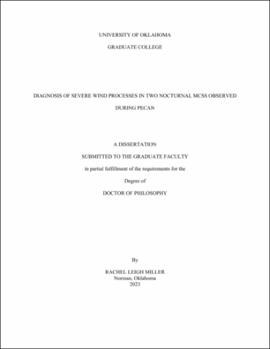Diagnosis of Severe Wind Processes in Two Nocturnal MCSs Observed during PECAN
Abstract
Severe wind processes in nocturnal mesoscale convective systems (MCSs) are not well understood since historically it has been assumed that these systems are elevated due to a stable surface layer. However, recent studies utilizing data from the Plains Elevated Convection at Night (PECAN) field project have shown that nocturnal MCSs behave like their afternoon counterparts once a surface-based cold pool is established. Many processes producing severe surface winds in MCSs have been observed and modeled such as mesovortices, microbursts, and the descent of the rear inflow jet. To further investigate these processes, two MCSs from the PECAN field project were selected for analysis due to their different evolution to cover a broad range of severe wind processes: the 25-26 June 2015 Kansas MCS and the 5-6 July 2015 South Dakota MCS. One radar analysis documented severe wind will be shown for the 25-26 June MCS. All other results will be presented from WRF simulations with three nested grids utilizing a vertically-integrated ice data assimilation scheme which produced simulated reflectivity that best resembled the observed reflectivity during the severe phases of the MCSs.
To investigate severe wind processes, backwards trajectories were calculated using WRF output from the inner-most nest with 333-m grid spacing every 5 seconds. This WRF output was first run through a pressure decomposition code to compute the pressure perturbation contribution from buoyancy pressure (pb) and both the linear and nonlinear dynamic pressure (pd). This allowed for gradients in the horizontal and vertical to be calculated along the trajectories for acceleration from pb and pd. Other variables analyzed along the trajectories include convective momentum transport (CMT), diabatic temperature tendency, vorticity, thermal buoyancy, and typical WRF output variables. Selected trajectories were analyzed every 30 minutes for both cases to cover three categories: sub-severe winds (20-26 m s-1), severe winds (> 26 m s-1), and significant severe winds (> 33.5 m s-1). While most of the typical WRF output variables were unable to discern between the three categories, the integrated acceleration from the horizontal buoyancy and dynamic forcing showed that within the last 5 and/or 2 minutes of the trajectory the increase in wind speed due to the dynamic forcing became larger than impacts from buoyancy. Over the entire trajectory time period, buoyancy forcing is the largest forcing term and explains increases in horizontal and vertical wind speed. This suggests that while all surface-based MCSs with an established cold pool will have buoyancy contributing the most to the wind speed, an extra contribution from some dynamic process is necessary for those winds to exceed the severe or significant threshold. For a more strongly forced system such as the 5-6 July MCS, the enhanced dynamic push came from leading line mesovortices. For a more marginal MCS such as the 25-26 June MCS, an updraft/downdraft couplet associated with horizontal vorticity would enhance the horizontal acceleration.
Collections
- OU - Dissertations [9477]
